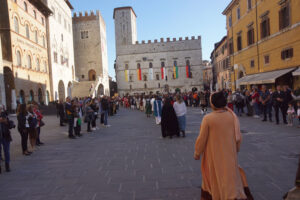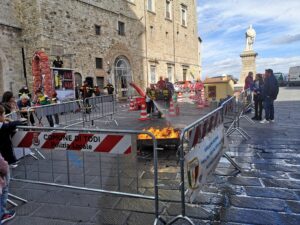Legend has it
that the city of Todi was built on top of the hill where it is located thanks to the indication of an eagle that showed the place to a team of masons who were building a village near the Tiber valley. The ruse used by the eagle was to steal the tablecloth from the builders’ mess and lay it on the exact spot where the city was to be built. For this reason, the eagle holding a cloth with its talons is the symbol of Todi.And there is also a street in the historic center called “Eagle’s Nest.”

Umbro Etruscan Period
History tells us that it was probably founded by Umbrians between the eighth and seventh centuries BC. The name Todi perhaps derives from the Etruscan Tutere,meaning boundary,perhaps to indicate the fact that the town was located on the border between the Umbrian settlement to the east and the Etruscan settlement located further west along the Tiber.
From the Umbro-Etruscan period, some sections of walls are still visible near Porta Liberia, in Via Paolo Rolli, in Via delle mura antiche and at Porta Marzia.
Roman Period
Todi becomes a Roman municipality
around the first century. BC. , a period during which the city underwent considerable expansion: the theater, the amphitheater, the temples of Jupiter Juno and Mars, the baths, the Market (the area bordered by the mighty wall with semicircular niches is still visible today, and finally a second circle of walls, of which the gates of Libera, S.Prassede, delle Milizie ,Aurea are still visible today.

The Medieval Period

In 760, Desiderio, king of the Lombards and Pope Paul I agreed on the boundaries of Todi’s territory on the side of the Duchy of Spoleto. In the first half of the 11th cent. Todi experienced its greatest territorial expansion, managing to subdue even the cities of Terni and Amelia. Around the middle of the 1200s ,the city was enclosed within the third and final circle of walls that tracing in part the layout of the second , lengthened to include Borgo nuovo and the ulpian suburb of porta fratta. In 1213 the Palazzo del Popolo was erected; in 1292 the Palazzo del Podesta’ e Capitano.Between 1334 and 1337 the City Council built the Palazzo dei Priori.
Having lost its autonomy as a free commune in 1368,Malatesta da Rimini,Biordo Michelotti,Ladislao D’Angio’ king of Naples,Braccio Fortebraccio da Montone,Francesco Sforza and finally after coming under the jurisdiction of the Church State,the Papal governor settled there as lords.
The modern and contemporary ages
Todi enthusiastically adhered to Napoleonic renewal proposals and unwillingly returned under papal rule. He participated,also, in the events of the Risorgimento and was very supportive of Garibaldi in the retreat of 1849, so much so that on the occasion of his passage through the town of Jacopone a cypress tree was planted in his honor that can still be seen today in the square dedicated to him.

During contemporary history Todi followed the fortunes of other small Umbrian towns and saw many of its citizens immolate themselves for their country during the two world wars. In the postwar period it was able to recover with the goodwill of its inhabitants and to move from a predominantly agricultural economy to one based on the tertiary sector,crafts and small industry;although tourism is still one of the most significant items . In the 1990s Todi had a peak of popularity thanks to the scientific research of an American scholar,Levine, who decreed Todi as the most livable city in the world . To find out if our friend was right, all you have to do is come and visit us:We look forward to seeing you as always with warmth and hospitality.